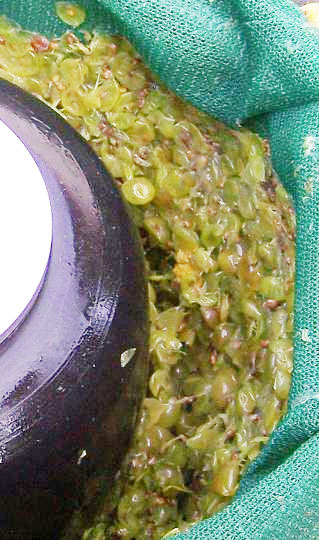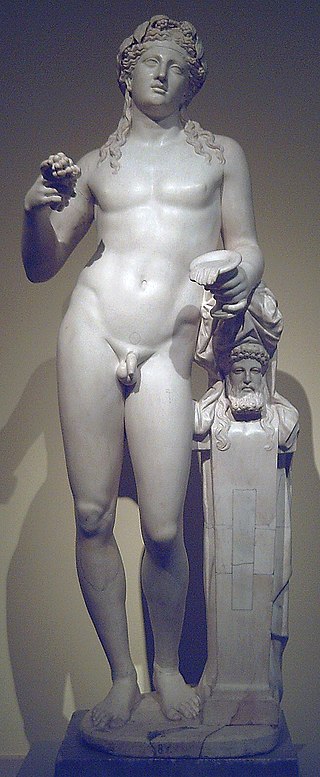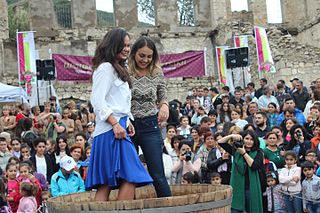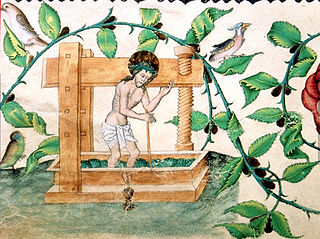
A grape is a fruit, botanically a berry, of the deciduous woody vines of the flowering plant genus Vitis. Grapes are a non-climacteric type of fruit, generally occurring in clusters.

Winemaking, wine-making, or vinification is the production of wine, starting with the selection of the fruit, its fermentation into alcohol, and the bottling of the finished liquid. The history of wine-making stretches over millennia. There is evidence that suggests that the earliest wine production took place in Georgia and Iran around 6000 to 5000 B.C. The science of wine and winemaking is known as oenology. A winemaker may also be called a vintner. The growing of grapes is viticulture and there are many varieties of grapes.

Pomace, or marc, is the solid remains of grapes, olives, or other fruit after pressing for juice or oil. It contains the skins, pulp, seeds, and stems of the fruit.

Red wine is a type of wine made from dark-colored grape varieties. The color of the wine can range from intense violet, typical of young wines, through to brick red for mature wines and brown for older red wines. The juice from most purple grapes is greenish-white, the red color coming from anthocyan pigments present in the skin of the grape. Much of the red wine production process involves extraction of color and flavor components from the grape skin.

White wine is a wine that is fermented without skin contact. The colour can be straw-yellow, yellow-green, or yellow-gold. It is produced by the alcoholic fermentation of the non-coloured pulp of grapes, which may have a skin of any colour. White wine has existed for at least 4,000 years.

A rosé is a type of wine that incorporates some of the color from the grape skins, but not enough to qualify it as a red wine. It may be the oldest known type of wine, as it is the most straightforward to make with the skin contact method. The pink color can range from a pale "onionskin" orange to a vivid near-purple, depending on the grape varieties used and winemaking techniques. Usually, the wine is labelled rosé in French, Portuguese, and English-speaking countries, rosado in Spanish, or rosato in Italian.

A winepress is a device used to extract juice from crushed grapes during winemaking. There are a number of different styles of presses that are used by wine makers but their overall functionality is the same. Each style of press exerts controlled pressure in order to free the juice from the fruit. The pressure must be controlled, especially with grapes, in order to avoid crushing the seeds and releasing a great deal of undesirable tannins into the wine. Wine was being made at least as long ago as 4000 BC; in 2011, a winepress was unearthed in Armenia with red wine dated 6,000 years old.

Maceration is the winemaking process where the phenolic materials of the grape—tannins, coloring agents (anthocyanins) and flavor compounds—are leached from the grape skins, seeds and stems into the must. To macerate is to soften by soaking, and maceration is the process by which the red wine receives its red color, since raw grape juice is clear-grayish in color. In the production of white wines, maceration is either avoided or allowed only in very limited manner in the form of a short amount of skin contact with the juice prior to pressing. This is more common in the production of varietals with less natural flavor and body structure like Sauvignon blanc and Sémillon. For Rosé, red wine grapes are allowed some maceration between the skins and must, but not to the extent of red wine production.
Vin gris is a variant of rosé wine made from red grapes, in particular Pinot noir and Pinot gris. Pinot noir is a black grape, but can also be used to make rosé or white wine. When the grapes are brought to the winery and crushed, the juice is run off and removed from contact with the skin, leaving the color and flavor compounds from the skin behind. The juice is then typically fermented in stainless steel tanks before being bottled shortly after, without any aging in oak barrels.
The glossary of wine terms lists the definitions of many general terms used within the wine industry. For terms specific to viticulture, winemaking, grape varieties, and wine tasting, see the topic specific list in the "See also" section below.

The following outline is provided as an overview of and topical guide to wine:

Straw wine, or raisin wine, is a wine made from grapes that have been dried off the vine to concentrate their juice. Under the classic method, after a careful hand harvest, selected bunches of ripe grapes will be laid out on mats in full sun.. This drying will probably be done on well exposed terraces somewhere near the wine press and the drying process will take around a week or longer. Small scale productions were laid out on flat roofs; however, if this still happens, it is extremely rare nowadays.

Ancient Rome played a pivotal role in the history of wine. The earliest influences on the viticulture of the Italian peninsula can be traced to ancient Greeks and the Etruscans. The rise of the Roman Empire saw both technological advances in and burgeoning awareness of winemaking, which spread to all parts of the empire. Rome's influence has had a profound effect on the histories of today's major winemaking regions in France, Germany, Italy, Portugal and Spain.

The aging of wine is potentially able to improve the quality of wine. This distinguishes wine from most other consumable goods. While wine is perishable and capable of deteriorating, complex chemical reactions involving a wine's sugars, acids and phenolic compounds can alter the aroma, color, mouthfeel and taste of the wine in a way that may be more pleasing to the taster. The ability of a wine to age is influenced by many factors including grape variety, vintage, viticultural practices, wine region and winemaking style. The condition that the wine is kept in after bottling can also influence how well a wine ages and may require significant time and financial investment. The quality of an aged wine varies significantly bottle-by-bottle, depending on the conditions under which it was stored, and the condition of the bottle and cork, and thus it is said that rather than good old vintages, there are good old bottles. There is a significant mystique around the aging of wine, as its chemistry was not understood for a long time, and old wines are often sold for extraordinary prices. However, the vast majority of wine is not aged, and even wine that is aged is rarely aged for long; it is estimated that 90% of wine is meant to be consumed within a year of production, and 99% of wine within 5 years.

The history of Champagne began when the Romans planted vineyards in this region of northeast France in the 5th century, or possibly earlier. Over centuries, Champagne evolved from being a pale, pinkish still wine to a sparkling wine. When Hugh Capet was crowned King of France in 987 at the cathedral of Reims, he started a tradition that brought successive monarchs to the region—with the local wine being on prominent display at the coronation banquets. The early wine of the Champagne region was a pale, pinkish wine made from Pinot noir.
This glossary of winemaking terms lists some of terms and definitions involved in making wine, fruit wine, and mead.

In winemaking, pressing is the process where juice is extracted from the grapes with the aid of a wine-press, by hand, or even by the weight of the grape berries and clusters. Historically, intact grape clusters were trodden by feet but in most wineries today the grapes are sent through a crusher/destemmer, which removes the individual grape berries from the stems and breaks the skins, releasing some juice, prior to being pressed. There are exceptions, such as the case of sparkling wine production in regions such as Champagne where grapes are traditionally whole-cluster pressed with stems included to produce a lighter must that is low in phenolics.

Kvevri or Qvevri - also known as Ch'uri in Western Georgia - are large earthenware vessels used for the fermentation, storage and ageing of traditional Georgian wine. Resembling large, egg-shaped amphorae without handles, they are either buried below ground or set into the floors of large wine cellars. Kvevris vary in size: volumes range from 20 litres to around 10,000; 800 is typical.

Grape-treading or grape-stomping is part of the method of maceration used in traditional wine-making. Rather than being crushed in a wine press or by another mechanized method, grapes are repeatedly trampled in vats by barefoot participants to release their juices and begin fermentation. Grape-treading was widespread in the history of winemaking, but with the introduction of industrial methods, it now survives mostly as a recreational or competitive activity at cultural festivals.

Christ in the winepress or the mystical winepress is a motif in Christian iconography showing Christ standing in a winepress, where Christ himself becomes the grapes in the press. It derives from the interpretation by Augustine and other early theologians of a group of passages in the Bible and is found as a visual image in Christian art between about 1100 and the 18th century, as well as in religious literature of many kinds. The image in art underwent a number of changes of emphasis, while remaining fairly consistent in its basic visual content, and was one of the relatively few medieval metaphorical or allegorical devotional images to maintain a foothold in Protestant iconography after the Reformation.


























